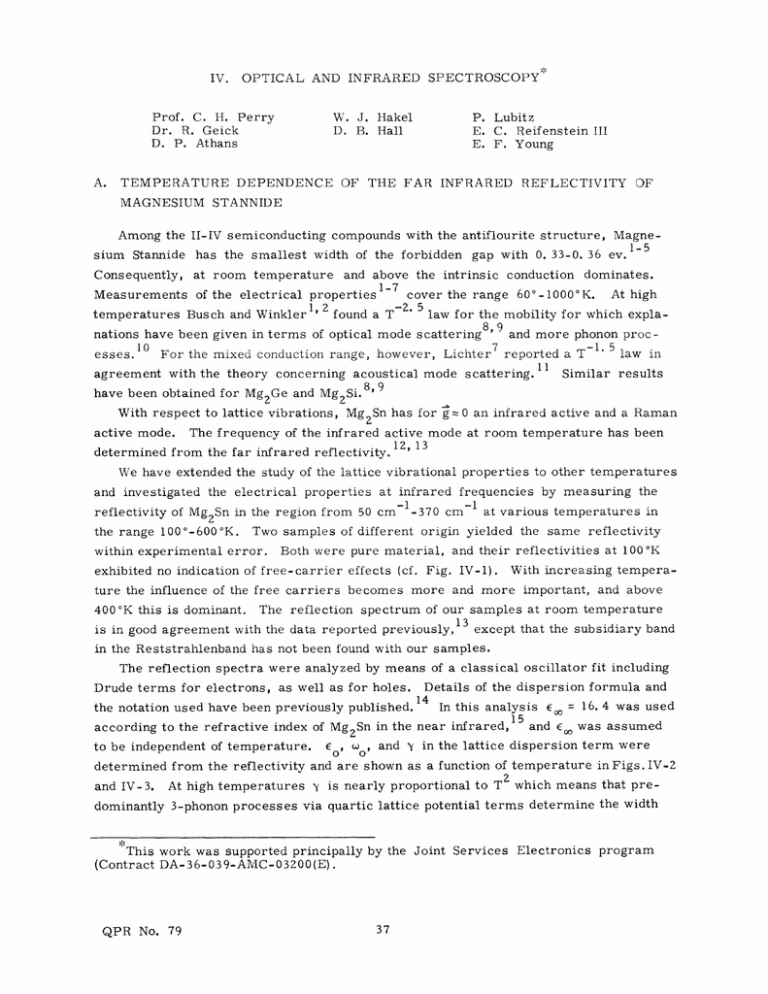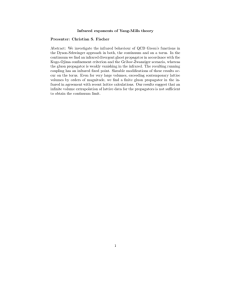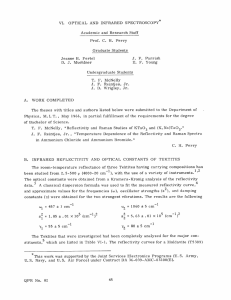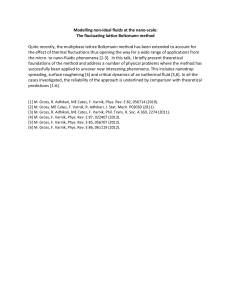IV. OPTICAL AND INFRARED SPECTROSCOPY'
advertisement

IV. OPTICAL AND INFRARED SPECTROSCOPY' Prof. C. H. Perry Dr. R. Geick D. P. Athans A. W. J. Hakel D. B. Hall P. Lubitz E. C. Reifenstein III E. F. Young TEMPERATURE DEPENDENCE OF THE FAR INFRARED MAGNESIUM REFLECTIVITY OF STANNIDE Among the II-IV semiconducting compounds with the antiflourite structure, Magne1-5 sium Stannide has the smallest width of the forbidden gap with 0. 33-0. 36 ev. Consequently, Measurements and above the intrinsic conduction dominates. 1-7 of the electrical properties cover the range 60 0 -1000 0 K. At high at room temperature temperatures Busch and Winkler l 2 found a T - 2 . 5 law for the mobility for which expla- nations have been given in terms of optical mode scattering 8 ' 9 and more phonon processes.10 For the mixed conduction range, however, Lichter 7 reported a T-1. 5law in agreement with the theory concerning acoustical mode scattering.11 Similar results 8 have been obtained for Mg 2 Ge and Mg 2 Si. ' With respect to lattice vibrations, Mg 2 Sn has for gz 0 an infrared active and a Raman active mode. The frequency of the infrared active mode at room temperature has been 13 determined from the far infrared reflectivity. 1 We have extended the study of the lattice vibrational properties to other temperatures and investigated the electrical properties at infrared frequencies by measuring the -1 -i at various temperatures in reflectivity of Mg 2 Sn in the region from 50 cm -370 cm the range 100 0 -600°K. Two samples of different origin yielded the same reflectivity within experimental error. Both were pure material, and their reflectivities at 100 K exhibited no indication of free-carrier effects (cf. Fig. IV-i). With increasing tempera- ture the influence of the free carriers becomes more and more important, and above 400 'K this is dominant. The reflection spectrum of our samples at room temperature is in good agreement with the data reported previously,13 except that the subsidiary band in the Reststrahlenband has not been found with our samples. The reflection spectra were analyzed by means of a classical oscillator fit including Details of the dispersion formula and 14 In this analysis E = 16. 4 was used the notation used have been previously published. 15 and E. was assumed according to the refractive index of Mg 2 Sn in the near infrared, Drude terms for electrons, as well as for holes. to be independent of temperature. Eo' 0 , and y in the lattice dispersion term were determined from the reflectivity and are shown as a function of temperature in Figs. IV-2 and IV-3. At high temperatures y is nearly proportional to T 2 which means that pre- dominantly 3-phonon processes via quartic lattice potential terms determine the width This work was supported principally by the Joint Services Electronics program (Contract DA-36-039-AMC-03200(E). QPR No. 79 WAVE LENGTH (microns) 25 30 40 50 60 80 100 200 400 625°K 1 90 70 520'K 70 50 420"K -90 360°K 60 Fig. IV-1. -20 Reflectivity of Mg 2 Sn at various temper- 7€ tures, experimental data (solid line) and calculated by means of classical dispersion formula (X). 330'K 90 70 295K 50 30 _-IO 0100*K 400 300 100 200 WAVE NUMBER (cm 0 - I 9.0 8 wu 8.0 190 180 200 400 600 TEMPERATURE (OK) Fig. IV-2. QPR No. 79 Temperature dependence of the infrared eigenfrequency the oscillator strength (E -E ) of Mg Sn. ° and OPTICAL AND INFRARED SPECTROSCOPY) (IV. 30 - I /i I II i / / / 1.5 /T // / o/ I /, ./ T / / I00 100 II 1I II 200 i 300 II I. i. I. 600 400 /. j -- 800 TEMPERATURE (OK) Fig. IV-3. Temperature dependence of the damping constant y in the lattice dispersion term for MgzSn. of the fundamental lattice band. 16 In the free-carrier part of the dispersion formula, too many parameters are involved to determine them all from the reflection spectra. For T = 100°K the free-carrier At room temperature a reasonable fit was effects could be neglected completely. obtained with the values reported from electrical measurements: 3 A. B. cm Intrinsic carrier concentration N. = 1. 5 • 10 3 * 1 Conductivity effective masses of electrons and holes, respectively, me = 0.15m 0 3 * and mh= 0. 10m o C. Mobilities of electrons and holes, = respectively, 9 3,7 cm 370 Vsec and h = S3, 7 300 cm cm V sec No attempt was made to vary the effective masses with temperature, and the room temperature values were used for all temperatures. proportional to T ratio used was - 2 The mobilities were assumed varying . 5 according to the results of Busch and Winkler. e/ph = 1. 23 independent of temperature. 3 ' 7 1 ' 2 The mobility The carrier concentration was determined from the reflectivity (cf. Fig. IV-4). For comparison Ni was calculated 1 3 * 3 * effective using the values m = 1. 20m 3 and mh = 1. 30m 3 for the density of 1 states 3 masses of the and the band value gap energy Eg (0.36-2.8 -4 masses and the value of the band gap energy Eg = (0.36-2.8 10 QPR No. 79 T) ev (cf. Fig. IV-4). (IV. OPTICAL AND INFRARED SPECTROSCOPY) The agreement of the experimental data with the calculated values is reasonable. An attempt was also made to fit the reflectivity with mobilities proportional to T-1. 5 according to the results of Lichter 7 in the mixed conduction range. The calculated T (OK) 5 800 500 300 50 2 -20 109 - - 10 E 0 Fig. IV-4. 5 -5 SIntrinsic z i -as S-2 carrier concentration N. versus 1/T determined from reflection spectra with 5 2 2 5 H (0) and with ~ T lated values of N. ( 1 < conductivity (-- ~ T -1. 5 (X), calcu) and total static ). 5 2 1017 2 3 I/TxlO 4 3 reflectivity is the same as in the former case within 2-3%0 for all temperatures and consequently, only one calculated value is shown in Fig. IV-1. The carrier concentration deviates systematically from the calculated values, and the ratio of the calculated to the experimental values is proportional to T. The resulting total static conductivity a- is o the same in both cases and thus the reflectivity is sensitive to the conductivity only. Furthermore, the plot log -o versus 1/T is not a straight line, which indicates once more a T -2 5 law for the mobilities (cf. Fig. IV-4). This means that already in the temperature range covered by our measurements the temperature dependence of the mobility cannot be explained by acoustical mode scattering only, 1 1 and that optical mode scattering or more phonon processes have to be considered.8- 10 Because of the relatively low mobility in Mg 2 Sn, the free-carrier effects produce no sharp plasma edge in the reflectivity which would have provided additional information. QPR No. 79 (IV. OPTICAL AND INFRARED SPECTROSCOPY) Such a minimum and a steep vise of the reflectivity always occur when the real part of the dielectric constant changes from positive to negative values with increasing wavelength and the imaginary part is sufficiently small. The corresponding condition is for a lattice dispersion term o(1) >>1, o ( ) and for a Drude term Nm * 2 i (2) E -> . Lattice *2 Nm Z < 1 for electrons, as well as for holes. ELattice Therefore no plasma edge has been found in the spectra. For MgZSn, condition 1 is fulfilled, but We wish to thank Professor D. W. Lynch, of Iowa State University, for providing one of the Mg 2 Sn samples. All computations were performed on the IBM 7094 computer at the Computation Center, M. I. T. R. Geick References 1. G. Busch and U. Winkler, Physica 20, 1067 (1954). 2. U. Winkler, Helv. Phys. Acta 28, 633 (1955). 3. H. G. Lipson and A. Kahan, Phys. Rev. 133, A800 (1964). 4. R. F. Blunt, H. P. R. Frederikse, and W. R. Hosler, Phys. Rev. 100, 663 (1955). 5. W. D. Lawson, S. Neilson, E. H. Putley, and W. Roberts, J. Electronics 1, 203 (1955). 6. H. P. R. Frederikse, (1955). 7. B. D. Lichter, J. Electrochem. Soc. 109, 819 (1962). 8. R. D. Redin, R. G. Morris, and G. C. Danielson, Phys. Rev. 109, 1916 (1958). 9. 10. R. G. Morris, R. D. Redin, and G. C. Danielson, Phys. Rev. 109, 1909 (1958). Ch. Entz, Physica 20, 983 (1954); Helvetia Phys. Acta 27, 199 (1954). 11. F. Seitz, Phys. Rev. 73, 549 (1948). 12. D. McWilliams and D. W. Lynch, Phys. Rev. 130, 2248 (1963). 13. A. Kahan, H. G. Lipson, and E. V. Loewenstein, Physics of Semiconductors, th ceedings of the 7 W. R. Hosler, and D. E. Roberts, Phys. Rev. 103, 67 Pro- International Conference, Paris, 1964, p. 1067. 14. R. Geick and C. H. Perry, Quarterly Progress Report No. 77, Research Laboratory of Electronics, M. I. T. , April 15, 1965, pp. 41-48. 15. D. McWilliams and D. W. Lynch, J. Opt. Soc. Am. 53, 298 (1963). 16. D. W. Jepsen and R. F. Wallis, Phys. Rev. 125, 1496 (1962). QPR No. 79







